Interns
...now browsing by category
Friday, August 21st, 2015

Lisa Koetke prepares a motion-activated camera. (Courtesy of Lisa Koetke)
by Chris Patrick
Imagine a swimming creature. It holds an antlered head above the water as its skinny, hooved legs tread underneath. A black stripe runs from its head to its tail, outlining a waggling white rump, revealing it to be a sika deer.
In 1916, a man named Clemment Henry released between four and six sika (the number isn’t certain) for hunting on James Island, off Maryland’s Eastern Shore. But it turns out sika are great swimmers—by 1962 they migrated to the Delmarva Peninsula and they now occupy every county of the lower Eastern Shore. Click to continue »
Posted in Ecology, From the Field, Interns, Invasive Species | Comments Off on Bucket Buffets Divulge Deer Preferences
Friday, August 14th, 2015
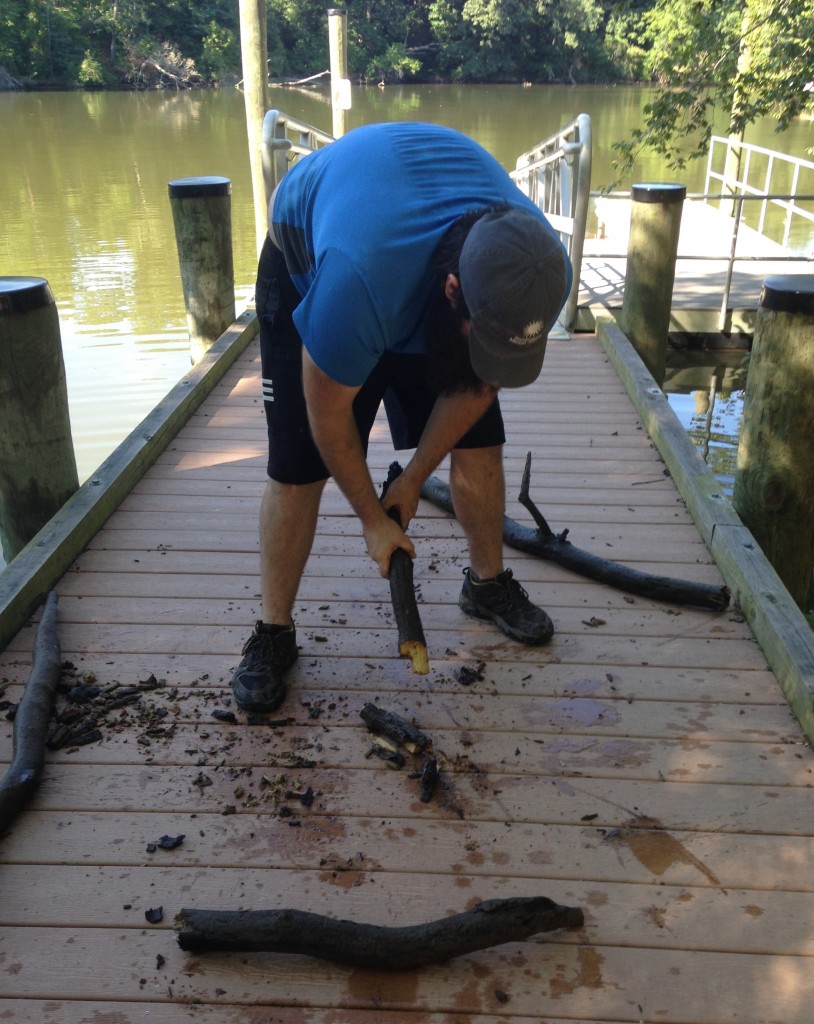
Darin Rummel smashes a stick against the dock. (SERC)
by Chris Patrick
Darin Rummel, intern in the marine invasions lab at the Smithsonian Environmental Research Center (SERC), raises a piece of wood twice the length of his arm and slams it onto a dock in the Patuxent River at Greenwell State Park in Hollywood, Md.
The soggy stick crumbles and a white-fingered mud crab scurries from the wreckage. Rummel adds the crab to a modest collection in a Tupperware container and raises the stick above his head again. Connor Hinton, another marine invasions lab intern, wades into a cove of muddy water in search of more crab-concealing wood. Click to continue »
Posted in Ecology, From the Field, Interns, Invasive Species | 1 Response »
Wednesday, July 8th, 2015
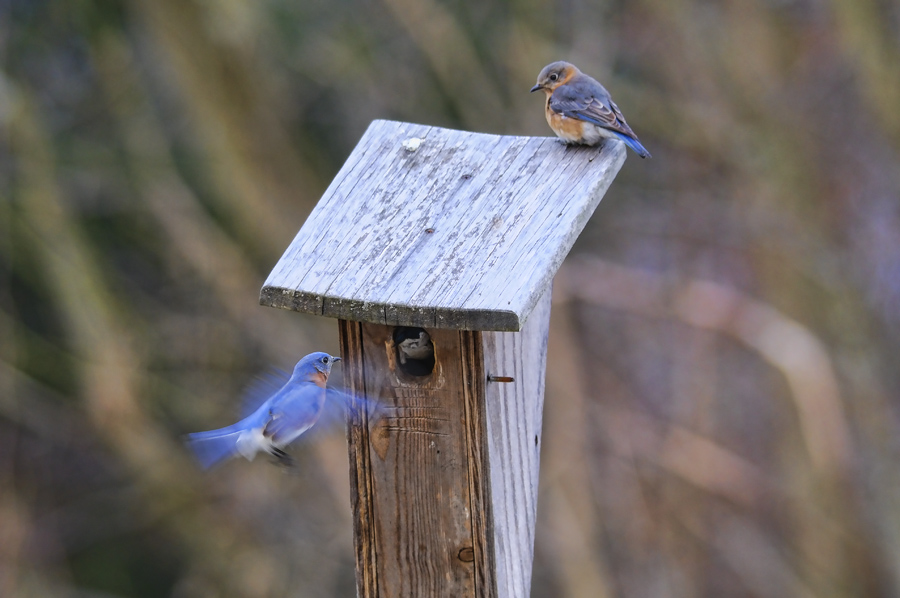
Male and female bluebirds at a nest box. (Matt Storms)
by Chris Patrick
Eastern bluebirds resemble flying, fist-sized jewels. Males are sapphire colored—royal-blue heads, backs, and wings contrast with rust-colored chests. Females are more gray than blue, but their wings are subtly tinted the same sapphire hue.
Since 2008, citizen scientists have monitored bluebirds at the Smithsonian Environmental Research Center (SERC). The Bluebird Project is citizen science intern Caroline Kanaskie’s self-proclaimed “baby” this summer. She is uncovering why bluebird numbers at SERC have been lower than usual. Click to continue »
Posted in Archaeology, Classes and Events, Ecology, Extreme Weather, From the Field, Interns, SERC Sites and Scenes | 1 Response »
Thursday, July 2nd, 2015
by Chris Patrick
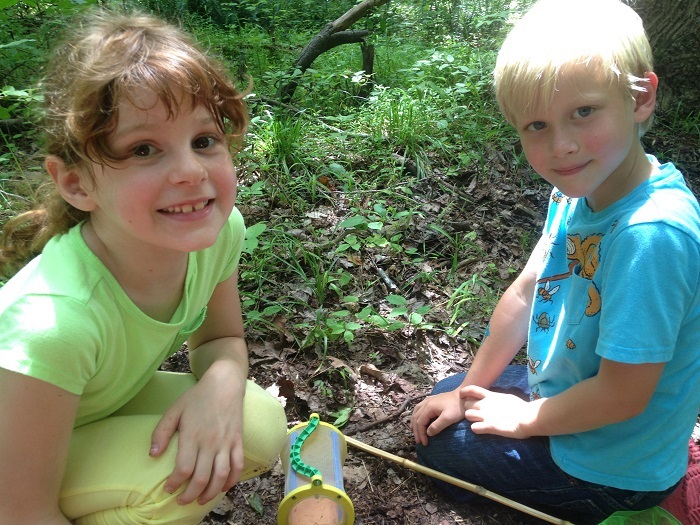
7-year-old Vivian and 6-year-old Gordon kneel in the dirt looking for insects.
“Camp Discovery!” shouts Smithsonian Environmental Research Center (SERC) education intern Josie Whelan.
“SCIENCE NINJAS!” a dozen 6- to 8-year-old campers respond as they strike ninja-esque poses. This is a callback, used by the three education interns—Henry Lawson, Addie Schlussel, and Whelan—to grab the attention of talkative future first- and second-graders at Camp Discovery. The education interns designed Camp Discovery this year, organizing a week of visits to SERC’s forests, fields, docks, and wetlands to foster understanding and respect for nature in campers. Click to continue »
Posted in Classes and Events, Ecology, Education, Interns, SERC Sites and Scenes | Comments Off on “Science Ninjas” Capture Bugs at Camp Discovery
Friday, June 26th, 2015
by Chris Patrick

Laurel Martinez checks her bread crate naked goby nests.
Plastic bread crates rest on the floor of the Rhode River, suspended by ropes from the Smithsonian Environmental Research Center’s dock. Eight PVC pipes arranged in a starburst sit horizontally on the bottom of the bread crates. In each tube there is a rolled sheet of thin, clear plastic. These rolled sheets are goby egg nests.
Or they’re supposed to be. Laurel Martinez, intern in the marine ecology lab this summer, slides out a plastic sheet and exclaims, “The mud crabs took over!”
This isn’t the plan. She wants the sheets to house naked gobies, bottom-dwelling fish. Martinez needs naked goby eggs for her summer project. Female gobies, who usually lay their eggs inside dead oyster shells, are supposed to go into the tubes, lay eggs on the plastic sheet, and leave. A male will fertilize the eggs and stay with them, guarding and caring for them until they hatch. Click to continue »
Posted in Climate Change, Ecology, From the Field, Interns, SERC Sites and Scenes | Comments Off on Building Plastic Nests and Gutting Fish in the Room of DOOM
Wednesday, November 26th, 2014
by Kristen Minogue
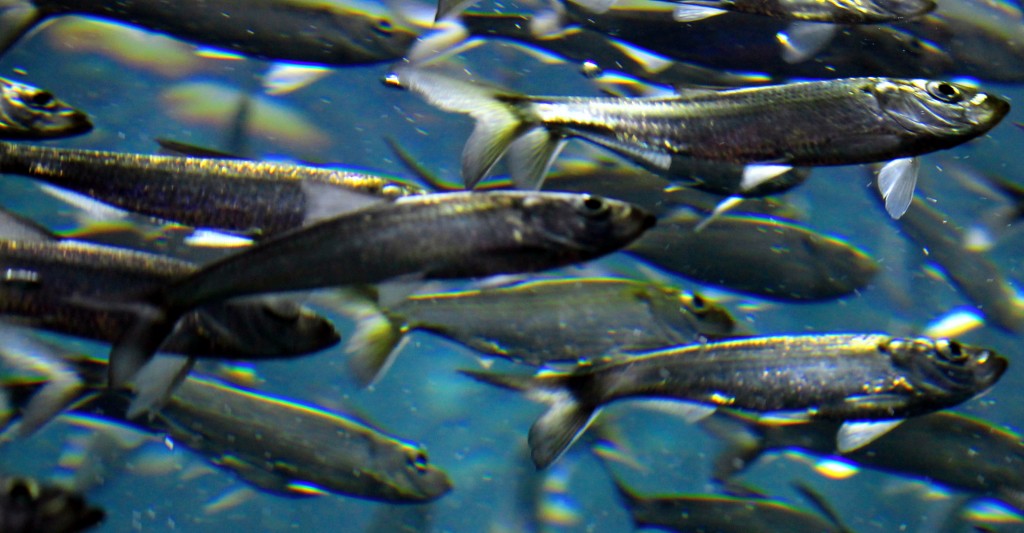
Alewives, one of two species of River Herring in Chesapeake Bay. (Geoffrey Gilmour-Taylor)
It’s no secret that River Herring are in trouble. There was a time, back in the 1950s, when Maryland fishermen regularly pulled in 4 million pounds or more a year of the silver fish. Then something mysterious happened. Herring harvests generally fluctuate from year to year. But in the 1970s, they fell and never came back up. For the last four decades, commercial fishermen in Maryland have been lucky to catch a few hundred thousand a year. Now they catch none.
Click to continue »
Posted in Ecology, Fisheries, Interns | Comments Off on Saving the River Herring: Don’t Let the Good Die Young
Friday, August 8th, 2014
by Sarah Hansen
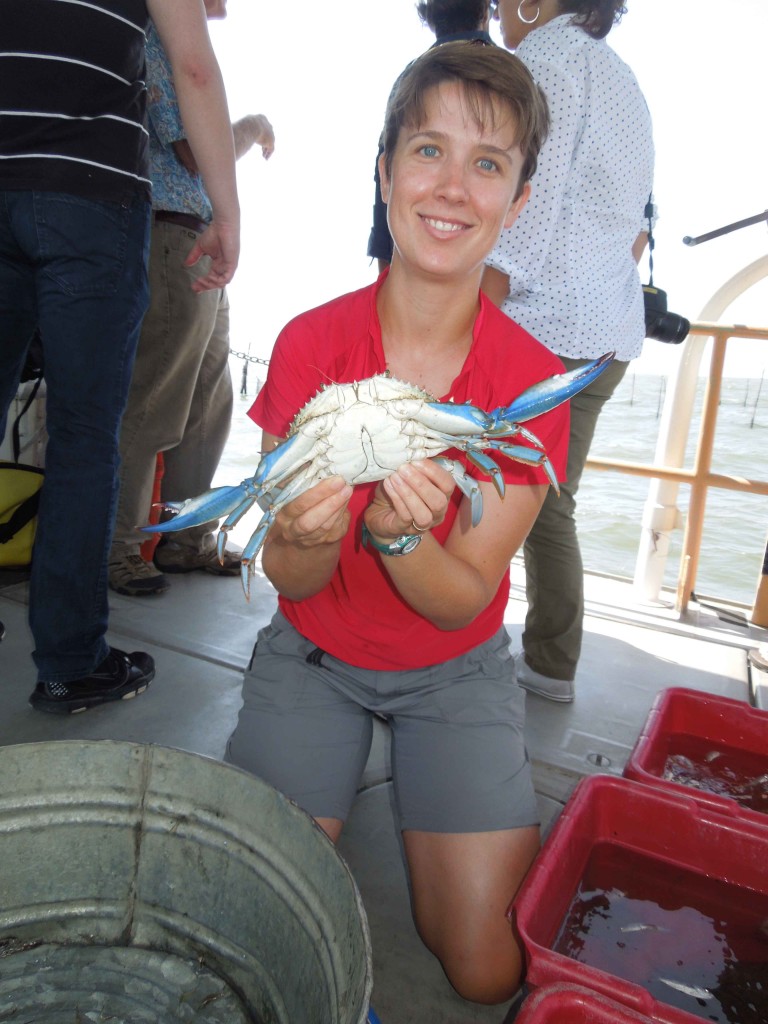
Julie Sepanik holds up a large male blue crab caught in the Rhode River. (SERC)
No one disputes that blue crab numbers in Chesapeake Bay are low. There is much discussion, however, about what to do to fix the problem. Smithsonian Environmental Research Center intern Julie Sepanik is working with SERC postdoctoral fellow Matt Ogburn to develop a computer model that will help improve our understanding of blue crab population dynamics in the Bay. The model works to identify where female crabs mature in the Bay and track their migration to lower Bay spawning areas. Ultimately, they hope the model will help inform decisions about preserving habitat and restoring the population.
Click to continue »
Posted in Ecology, Fisheries, Interns | Comments Off on Virtual crabs could help real recovery
Monday, July 21st, 2014
by Dejeanne Doublet
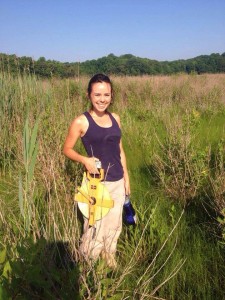
SERC intern Dejeanne Doublet heads out to sample marsh elder.
(Megan Palmer)
As we’re knee-deep in the marsh surrounding the Chesapeake Bay, working under the relentless sun during 90-degree weather with 90 percent humidity, sweat dripping down our faces, waving off the summer bugs and trying to collect as much field data as possible, the idea of winter becomes abstract and far-fetched. It’s hard to believe we are out here in the blazing heat of summer studying the effects of this past winter— one of harshest winters this area has endured in many years.
Click to continue »
Posted in Climate Change, Ecology, Extreme Weather, Interns, SERC Sites and Scenes | Comments Off on Intern Logs: A Summer Quest
to Understand Winter
Thursday, July 17th, 2014
By Sarah Hansen
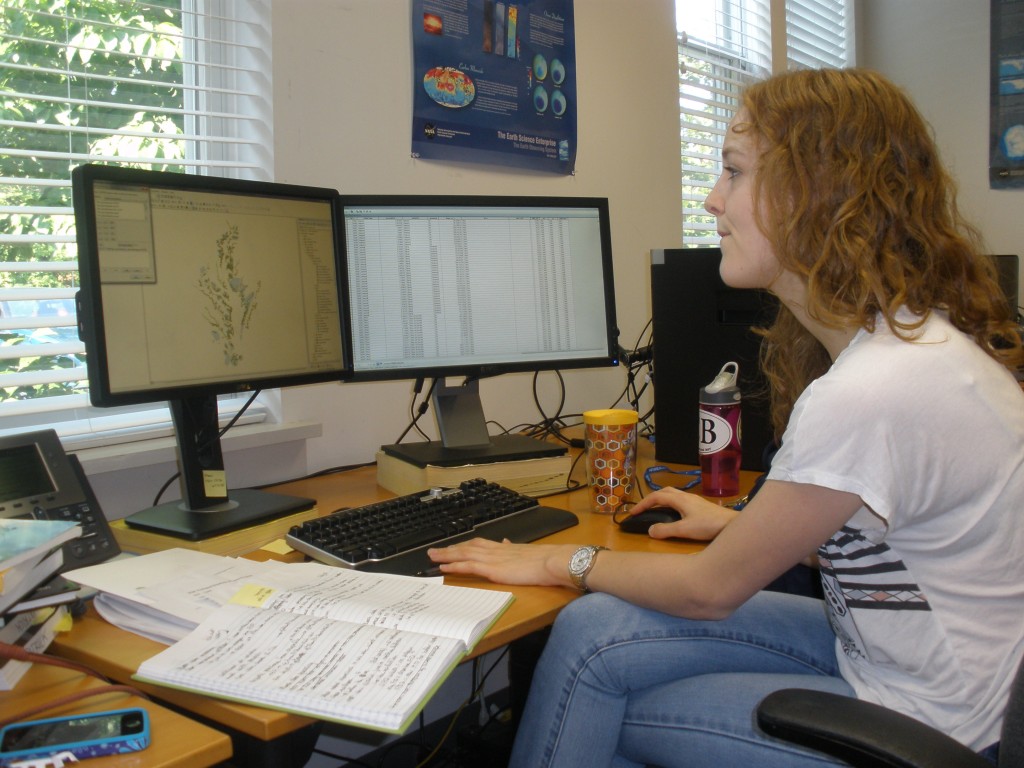
SERC intern Bridget Smith, immersed in a sea of environmental data. (SERC)
Underwater plants like sea grasses provide habitat and feeding areas for a wide range of aquatic life. They also help filter the water and put the brakes on erosion. But in Chesapeake Bay, the coverage of underwater plants, or submerged aquatic vegetation (SAV), has been low for decades, and restoration attempts have had mixed results. That’s why this summer, Smithsonian Environmental Research Center intern Bridget Smith is grappling with 28 years of data to explore which of a host of factors affects SAV in the Bay and how.
Click to continue »
Posted in Ecology, Interns, Land Use, SERC Sites and Scenes, Water Quality | Comments Off on Using Computer Models to Help Rescue Bay’s Underwater Flora
Wednesday, July 9th, 2014
By Sarah Hansen
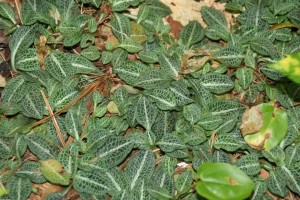
A cluster of downy rattlesnake plantain, the orchid species SERC intern Christopher Robinson is studying this summer. (Wikimedia Commons user Cdc25A)
Orchids are beautiful plants to be treasured, and fungi are gross moldy blobs to avoid at any cost. At least, that’s what some people may think. But it turns out that no orchid can germinate and grow without a fungal partner. Smithsonian Environmental Research Center scientist Melissa McCormick has been learning about the relationship between orchids and fungi for 15 years. This summer, though, intern Christopher Robinson is helping put a new twist on the research. Click to continue »
Posted in Ecology, Interns | Comments Off on Orchid, Fungi and Bacteria Relationships:
“It’s Complicated”











